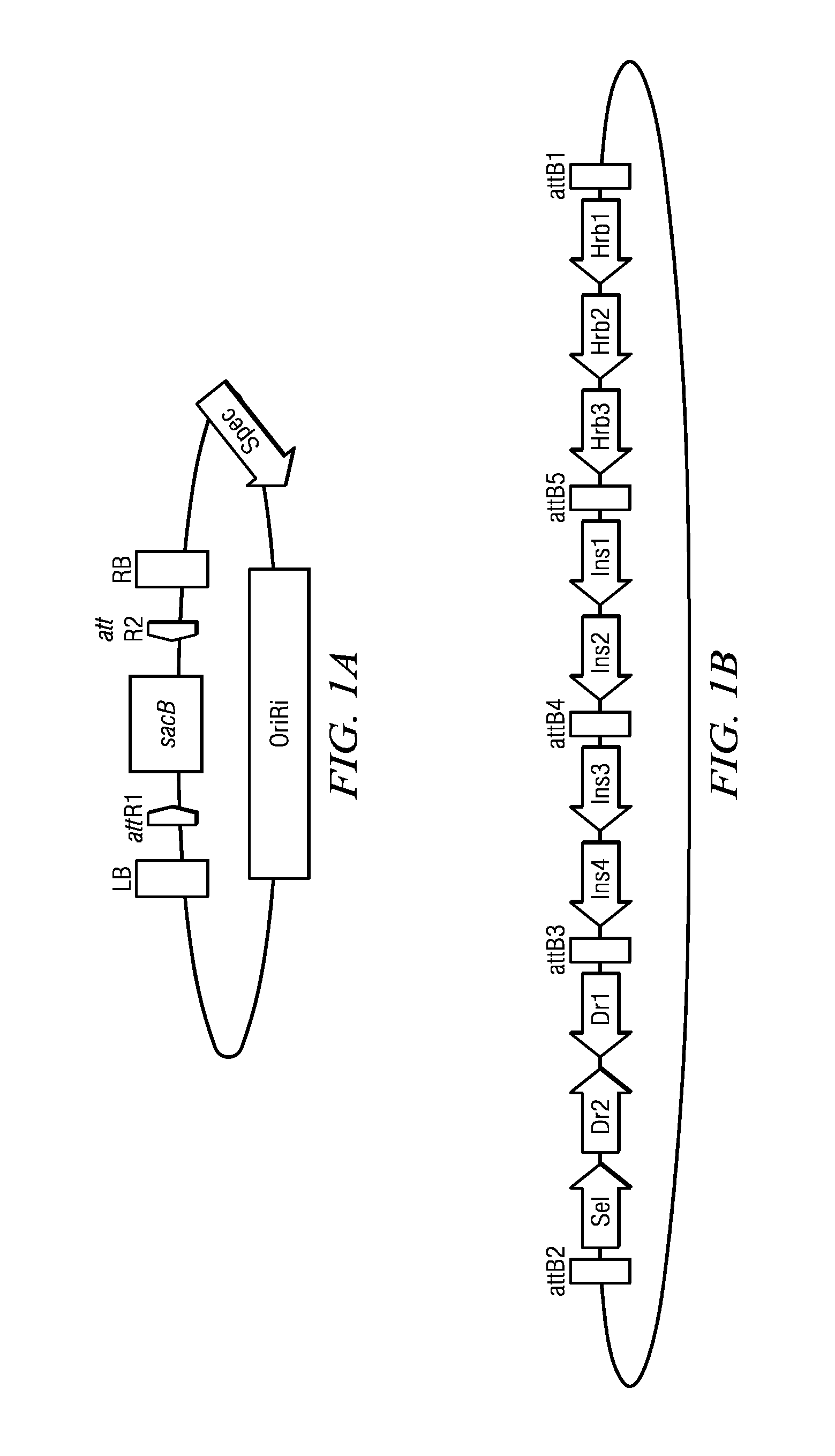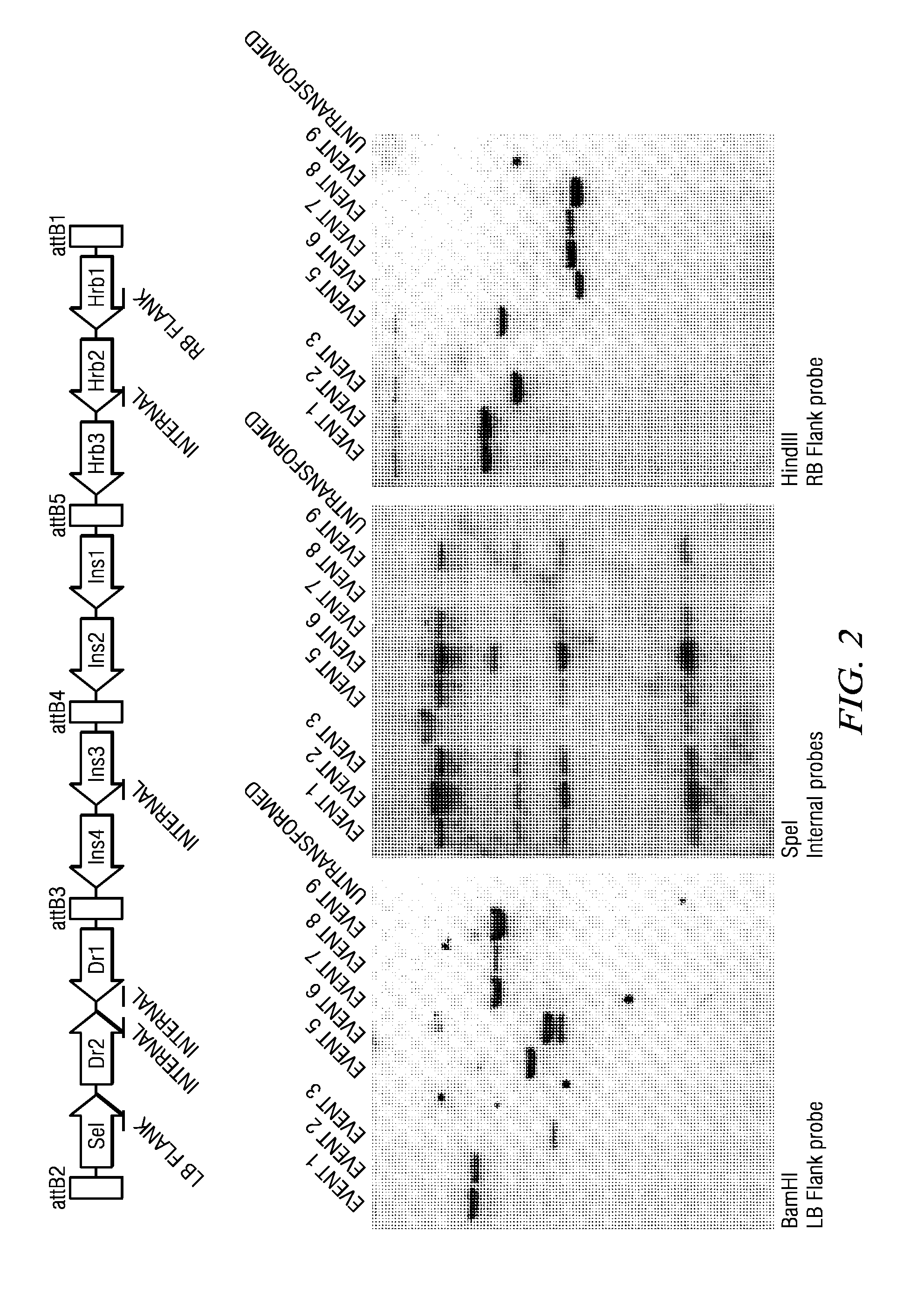Methods and Compositions for Expression of Transgenes in Plants
a technology of transgenes and compositions, applied in the field of molecular biology, can solve the problems of cost and time-consuming, and achieve the effect of reducing the cost and time-consuming of transgene expression in host cells and organisms
- Summary
- Abstract
- Description
- Claims
- Application Information
AI Technical Summary
Benefits of technology
Problems solved by technology
Method used
Image
Examples
example 1
Construction of Vectors with Multiple Expression Cassettes
[0177]Vectors were constructed comprising either 6 or 10 expression cassettes (and 6 or 10 distinct genes). Table 1 illustrates the traits conferred by each of the transgenes in the multi-transgene vectors. Hrb1, Hrb2 and Hrb3; represent herbicide tolerance genes, Dr1 and Dr2 represent drought resistance genes; Ins1, Ins2, Ins3 and Ins4 represent insect resistance genes; and Se1 represents a selectable marker gene. Also shown in Table 1 are the expression control sequences, promoter, intron and terminator that were included in each vector. Table 2 shows the number of times each promoter, intron and terminator sequence were repeated in the 10 gene construct. For construction of the multi-transgene vectors individual blocks of expression cassette sequences were cloned into a parent vector and the GATEWAY™ recombinase system was used to generate the fully formed multiple gene vector. The GATEWAY™ recombination reaction was used ...
example 2
Transformation of Plant Cells
[0178]Agrobacterium comprising the 10 and 6 gene vectors were used for transformation of maize immature embryos. Transformation efficiency and quality (percent single copy, backbone free sequence) was assess for the 6 and 10 gene vectors and compared to a control, 2 gene, transformation. Results of these analyses are shown in Table 3. Most transgenic events expressed all transgenes.
TABLE 3Transformation EfficiencyT-DNA% single copyStackSize (kb)ExplantsEventsTF (%)backbone free 2 gene6.64407918.065.8 6 gene174406915.739.110 gene32440204.555.0
[0179]Results of the transformation analysis demonstrated that transformation efficiency (TF) decreases as the number of genes in the transformation vector increased. Surprisingly, however, the 10 gene vector demonstrated enhanced transformation quality relative to the 6 gene vector and generated a significantly greater portion of single copy, backbone free inserts.
example 3
Characterization of Transformed Plant Cells
[0180]Transgenic events comprising the 10 gene vector were next subjected to Southern blot analysis to determine whether the transformation events comprised the intact 10 gene insertion. Results of the analysis from 9 events are shown in FIG. 2. Results of the analysis demonstrate that most events contained one, intact T-DNA insert. These results were further confirmed by FISH analysis of the three events shown in FIG. 3.
[0181]The 10 gene transformation events were next characterized for expression of the various transgenes. Table 4 shows the relative RNA expression from each of the transgenes compared to control expression vectors. In the case of Dr1 and Dr2, expression was compared to expression in a line comprising a transformation event of two transgenes (Dr1 and Dr2). Likewise for Ins1 and Ins2 expression was compared to expression in a line comprising a transformation event of two transgenes (Ins1 and Ins2). In the case of Hrb1, Hrb2 ...
PUM
| Property | Measurement | Unit |
|---|---|---|
| Electrical resistance | aaaaa | aaaaa |
| Drought | aaaaa | aaaaa |
| Sterile | aaaaa | aaaaa |
Abstract
Description
Claims
Application Information
 Login to View More
Login to View More - R&D
- Intellectual Property
- Life Sciences
- Materials
- Tech Scout
- Unparalleled Data Quality
- Higher Quality Content
- 60% Fewer Hallucinations
Browse by: Latest US Patents, China's latest patents, Technical Efficacy Thesaurus, Application Domain, Technology Topic, Popular Technical Reports.
© 2025 PatSnap. All rights reserved.Legal|Privacy policy|Modern Slavery Act Transparency Statement|Sitemap|About US| Contact US: help@patsnap.com



